hi,
just like to share my new tube pre-amp, it is based on 7N7 tube, it 's a medium-mu dual triode, the Loctal equivalent of the 6SN7:

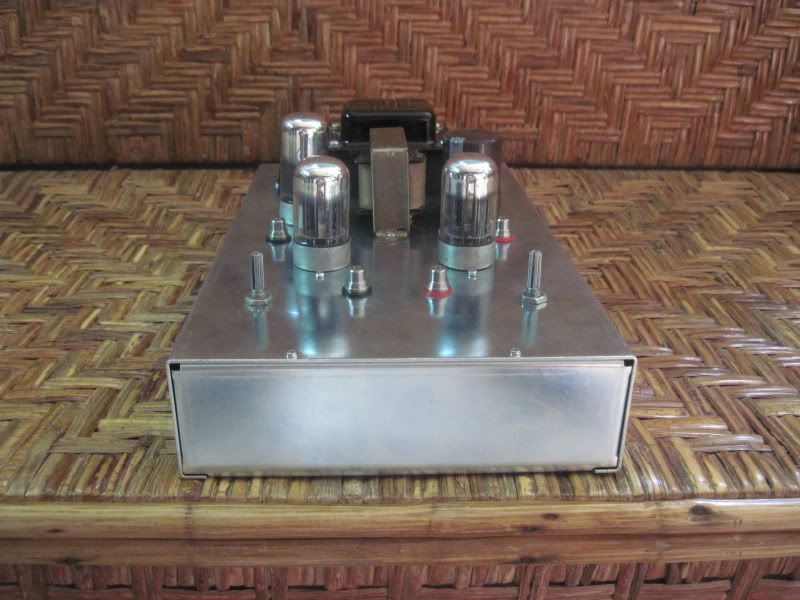

preparation of the chassis required drilling and nibbling the chassis to punch out holes:
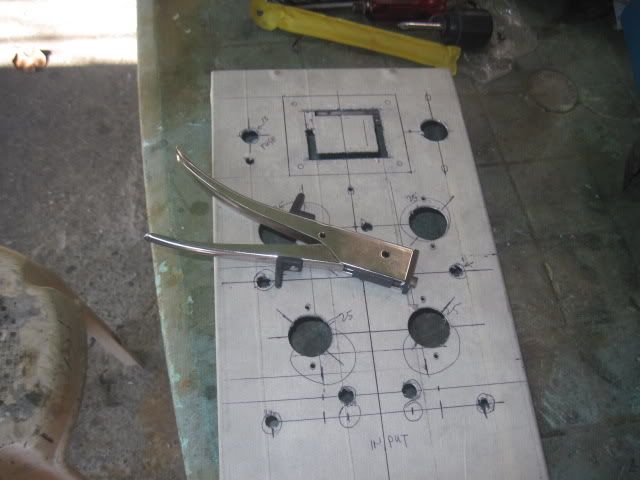


hole saws and drill bits were used utilising a small bench drill i got before christmass, nibbling tool for rectangular cut-out proved to be very handy:
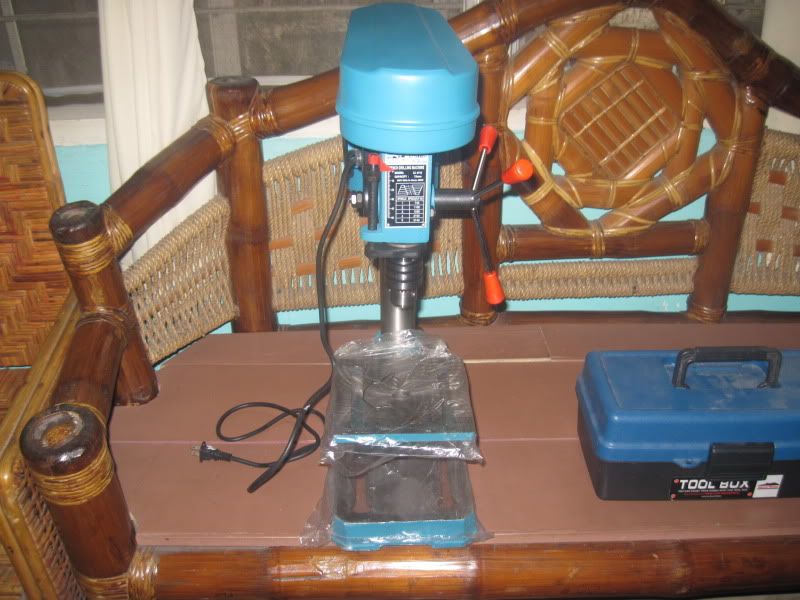
these are traffos i built, i used the one with 6.3 volt heater winding only. the endbell were replaced with those supplied by edrel, thanks edrel...

the circuit is a classic common cathode input, cathode follower output stages. the twist here is that led's were used to bias the cathode follower.
operating point was chosen at about 150 volts and 5mA for both stages. this is desireable so that the net ac current draw from the power supply is zero.
the power supply was designed to provide 300volts at 30mA, the transformer i designed for the amp barely heats up in use.... the power supply is a hybrid type, using a 7X6 full wave rectifier and a diode bridge.....apportionment of supply current is as follows; 10 mA for the 300v composite zener diode string as shunt regulators and 10 mA each for both L and R channels.
this is the schematic diagram:
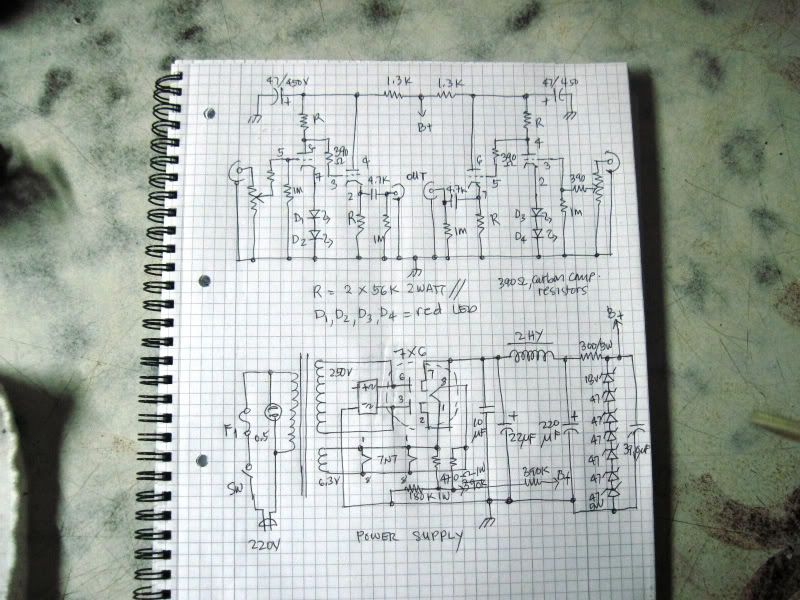
more pictures:

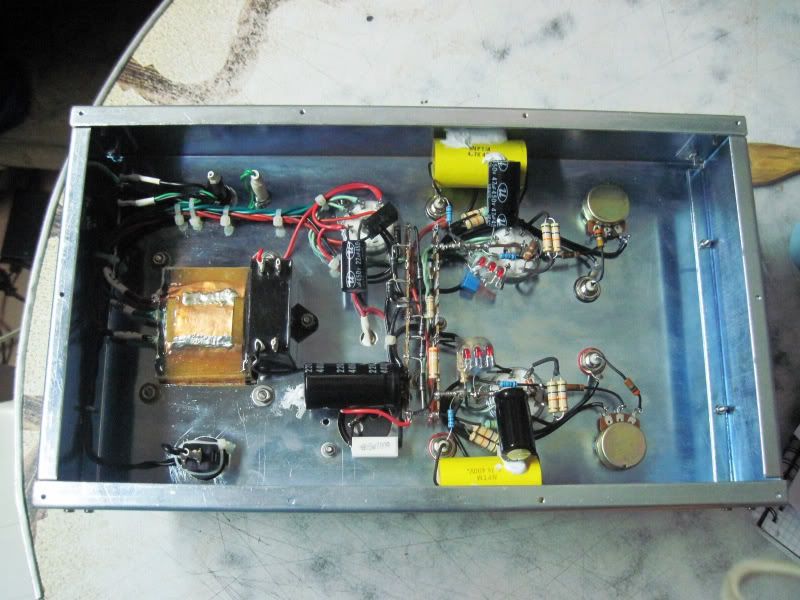
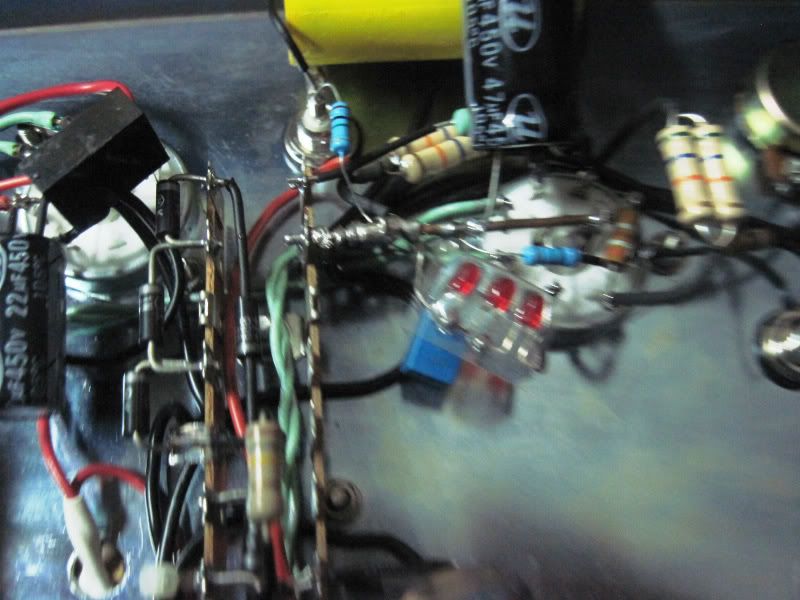
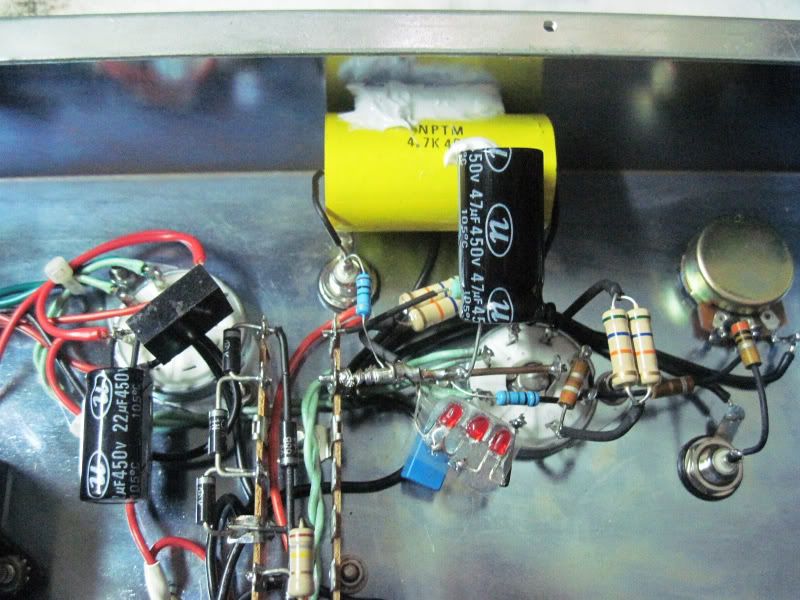
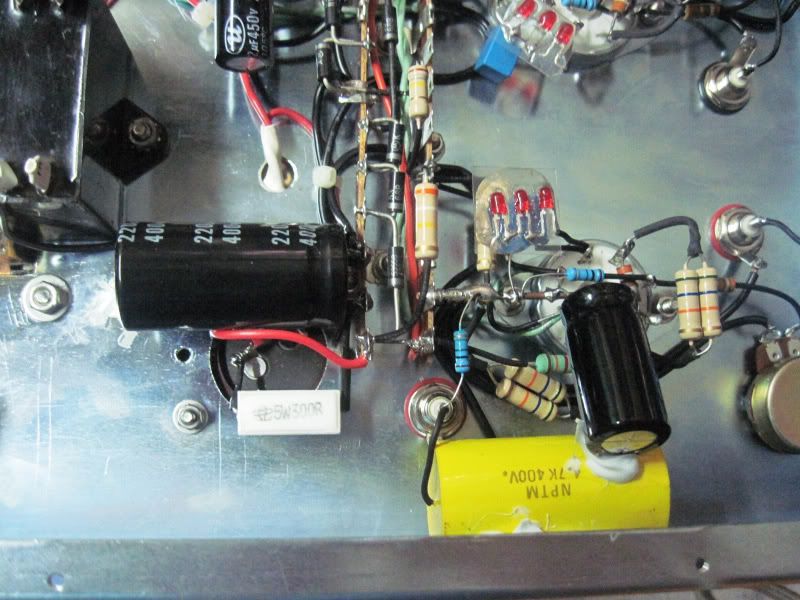

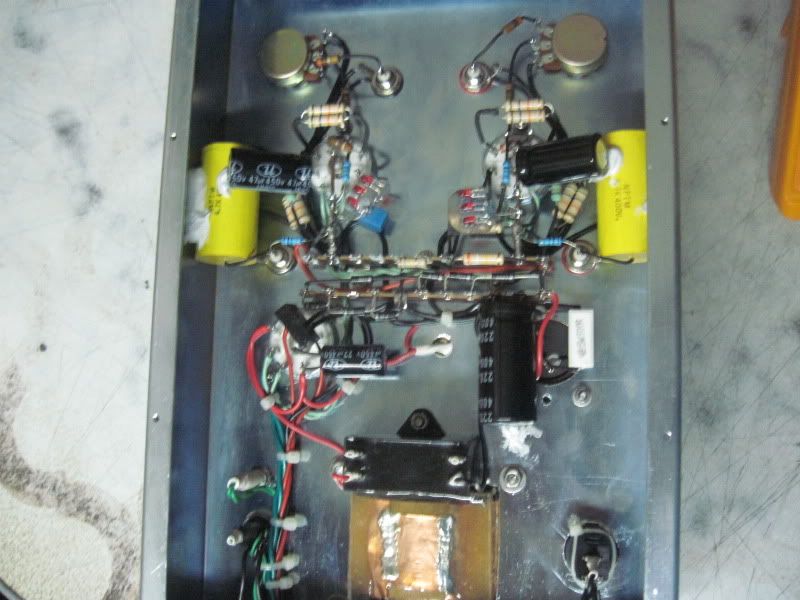
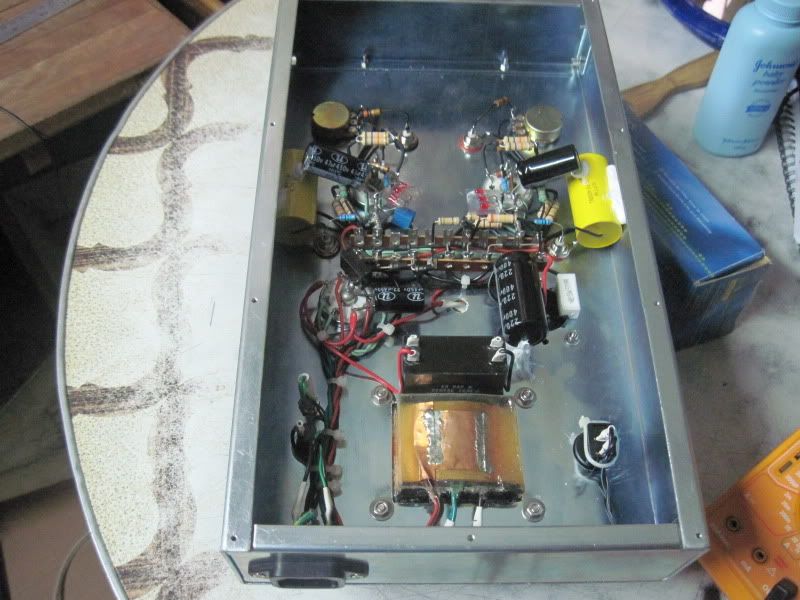
so how was the sound? i would say that this preamp is quiet and makes good sound driving a Sure T-amp as it is supposed to do......🙂
just like to share my new tube pre-amp, it is based on 7N7 tube, it 's a medium-mu dual triode, the Loctal equivalent of the 6SN7:



preparation of the chassis required drilling and nibbling the chassis to punch out holes:



hole saws and drill bits were used utilising a small bench drill i got before christmass, nibbling tool for rectangular cut-out proved to be very handy:

these are traffos i built, i used the one with 6.3 volt heater winding only. the endbell were replaced with those supplied by edrel, thanks edrel...

the circuit is a classic common cathode input, cathode follower output stages. the twist here is that led's were used to bias the cathode follower.
operating point was chosen at about 150 volts and 5mA for both stages. this is desireable so that the net ac current draw from the power supply is zero.
the power supply was designed to provide 300volts at 30mA, the transformer i designed for the amp barely heats up in use.... the power supply is a hybrid type, using a 7X6 full wave rectifier and a diode bridge.....apportionment of supply current is as follows; 10 mA for the 300v composite zener diode string as shunt regulators and 10 mA each for both L and R channels.
this is the schematic diagram:

more pictures:








so how was the sound? i would say that this preamp is quiet and makes good sound driving a Sure T-amp as it is supposed to do......🙂
That's really cool! I have buckets of those old loctal tubes and wasn't sure if they would ever see life again. Thank you Tony, I just got motivated to try something new!
You show two Cathode LEDs on drawing and three in pics...this lowers your current through 7N7 from 5ma, correct?
I have a similar pre I am experimenting with, except I have the back 6SN7 as a phase splitter for a balanced output. I have a bit of hum tho, haven't played with it much...maybe I will play with it a little more. I should start with a lower B+ (I am running 230V B+, 22K plate Resistor, and two red LEDs on cathode...)
I have a similar pre I am experimenting with, except I have the back 6SN7 as a phase splitter for a balanced output. I have a bit of hum tho, haven't played with it much...maybe I will play with it a little more. I should start with a lower B+ (I am running 230V B+, 22K plate Resistor, and two red LEDs on cathode...)
You show two Cathode LEDs on drawing and three in pics...this lowers your current through 7N7 from 5ma, correct?
I have a similar pre I am experimenting with, except I have the back 6SN7 as a phase splitter for a balanced output. I have a bit of hum tho, haven't played with it much...maybe I will play with it a little more. I should start with a lower B+ (I am running 230V B+, 22K plate Resistor, and two red LEDs on cathode...)
yes, the final amp used 3 led's, smaller ones to get the current to 5ma....
this amp is very clean, no microphonics, no hum....i lifted the heaters to about 95volts, using voltage devider strings since dc coupling was used....
That's really cool! I have buckets of those old loctal tubes and wasn't sure if they would ever see life again. Thank you Tony, I just got motivated to try something new!
loctal sockets are now available, i got mine from shang zheng, ebay seller.....
i used a loktal rectifier tube as well........😀
yes, the final amp used 3 led's, smaller ones to get the current to 5ma....
I thought all RED LEDs were around 1.7V drop regardless of size...
those red led's i used had 1.5volts drop, what i did was to string them on a breadboard and run 5ma thru them using a 12 volt supply......then i soldered them into a string and fixed them on plastic film using clear epoxy......
very nice preamp tony.. 🙂
thanks, the rectifier tube 7X6 costs $1 and the 7N7 costs $8 at rogalski's in Florida......this is a bang for the buck preamp....
Nice preamp. Something about the industrial strength look of the locktals is appealing to me. 🙂 What is the purpose of the 390 ohm resistors? Grid stoppers? Does having the 1M grid leaks connected directly to the grid pin compromise their effectiveness?
Nice preamp. Something about the industrial strength look of the locktals is appealing to me. 🙂 What is the purpose of the 390 ohm resistors? Grid stoppers? Does having the 1M grid leaks connected directly to the grid pin compromise their effectiveness?
yes, those 390 ohms are carbon comps that i have lying around....the 1meg grid leak are there just for insurance in case the pots lose contacts....
this amp is dead quiet, no hum, no hiss, i am very much satisfied with this preamp...
The only reason I asked was that I have usually seen the grid leak on the other side of the stopper and I wasn't sure if it made any difference. Good job.
The only reason I asked was that I have usually seen the grid leak on the other side of the stopper and I wasn't sure if it made any difference. Good job.
indeed, the decision to do that was more of construction convinience than anything....😀
The circuit is a classic common cathode input, cathode follower output stages
Tony, I tried that exact circuit with OK results, but since changed to the paralleled plate follower (to drop output impedance). Sounds a bit better to my ears.
the 6922/6dj8/ecc88/6h23/6n1p give you the same results without paralleling sections of tubes...
Yes, but paralleling the tubes halves the output impedance - kinda important if you have a low input impedance SS amp
Nice work. I've been using a 7N7 preamp for several years now. It started out as a Bottlehead Foreplay, then morphed into the amp it is now. Active loads on the plates of the voltage amp half, LED bias, and active loads on the cathode follower half. SS, pseudo dual mono PSU. Sounds fabulous!
An externally hosted image should be here but it was not working when we last tested it.
An externally hosted image should be here but it was not working when we last tested it.
Last edited:
nice one, did you get rid of those aligators? 🙂
LOL! I thought of it, but could never ask. Well, I'll take alligators over no implementations at all any day. 🙂
- Status
- Not open for further replies.
- Home
- Amplifiers
- Tubes / Valves
- tony builds a 7N7 preamp